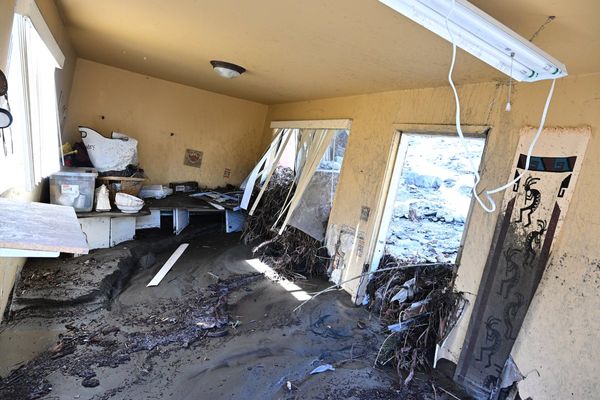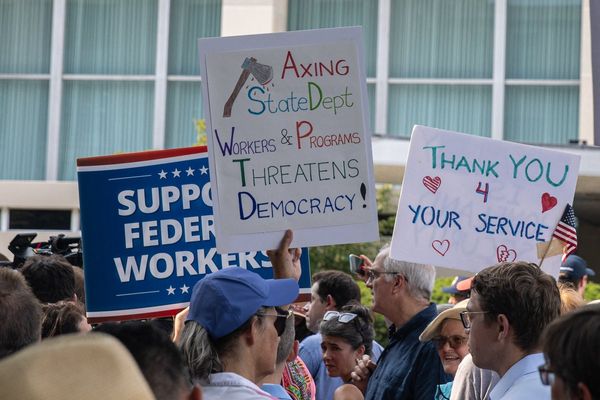
The thick forest buzzes with life in the background as a circle of women meet in an open-air hall in Triana, a mountainside hamlet in Colombia’s verdant Pacific region. Doña Gloria walks up to each person and pours a shot of viche from a herb-infused bottle.
“For us, viche is a distillate of wisdom, ancestry and culture,” says Gloria, a master viche maker and leader of the Association of Black and Indigenous Peasant Women of Buenaventura (AMUCIB). “Viche is the blood which runs through our veins. Without blood, there is no life.”
Viche, a sugar cane-based alcoholic drink, has been artisanally produced by African-Colombian communities for about 300 years. When mixed with specific plants it can be a medicine, a midwife’s aid for childbirth, or an alternative morning pick-me-up in a country renowned for its coffee. Now, the drink has also become a way to fight the threat of armed gangs recruiting young people of the African-Colombian communities.

The dense forests and waterways of the region are of strategic importance for Revolutionary Armed Forces of Colombia (Farc) dissidents, traffickers and illegal armed groups. While Farc and the national government signed a peace agreement in 2016, many illegal armed groups – including Farc dissidents – still operate in the region, involved in illegal mining and the drug trade.
“Young people don’t have opportunities,” says Catholic bishop Mario Álvarez Gómez. The church has partnered with various communities in the region to aid the peace process. “They are cannon fodder for these groups because the state doesn’t give them opportunities.”
The threat is not an abstract one in Triana, which has been caught in the conflict between illegal armed groups before: in 2000 it was the site of a massacre by paramilitaries.
On 15 January, a three-month ceasefire negotiated with armed groups by the Colombian president, Gustavo Petro, comes to an end. To counter the renewed possibility of young people becoming involved in organised crime and the degradation of nature, community leaders from Triana are betting on manufacturing viche and strengthening African-Colombian traditions to create jobs and opportunities.
Álvarez says that peace will require more than putting down weapons. “I believe the reconstruction of the social fabric goes hand-in-hand with the conquest for peace. If this social fabric is not rebuilt, peace will be more and more elusive,” he says.

Like Mexico and mezcal or Brazil and cachaça, Colombia is positioning viche to become a primary world-class export industry. Producers such as Gloria argue that viche has a critical role in generating jobs and income, preventing crime, combating the attractiveness of armed groups, and preserving the region’s environment by creating an economic livelihood.
She helps communities develop business strategies for commercialising the drink, enabling them to improve income and strengthen local economies. Gloria, who also manages a business startup “incubator” for young people in the viche-making communities, says: “If you buy viche from the communities, it makes sense for the community to plant sugar cane, and their development makes sense. So the young people can continue without losing the essence or the reason for being rural people and peasant women and men, especially Black women and men.”
Wasinton Carabalí, a youth leader helping with the project, grew up in Timbiquí, a viche-producing village. His grandmother made the drink traditionally, growing sugar cane on a small plot of land and herbs in raised beds. With other women, she would squeeze the juice to make guarapo, which was fermented and then distilled into viche.
“What we do is continue to contribute to recovering community practices,” says Carabalí.
The ancestors of these communities brought from Africa the use of certain plants and a balanced approach to rural life. The sugar cane and herbs used in making viche are grown using environmentally friendly multiple cropping methods, and African-Colombian territories have some of the country’s best-preserved forests.

“I’m delighted to be in this world because it’s been a process that invites you to reflect and value what is ours,” says Carabalí. “Sometimes young people disconnect a lot from that legacy, from that integral part of us.”
In 2021, the Colombian government enacted a new law establishing rules and regulations for the processing and commercialising of viche. It restricted production of the drink to ancestral African-Colombian communities in the Pacific region and was supposed to help communities become more confident in commercialising the product outside ancestral territories.
Consumption of viche has boomed in recent years in big urban areas such as Bogotá and Medellín, where a decade ago it was almost unheard of. This new popularity outside traditional areas has been attributed to the Petronio Alvarez Pacific cultural festival, held every August in Cali. In 2022, 325,000 visitors attended the event.
However, apart from at cultural events such as Petronio Alvarez and the annual Viche festival in Triana, and in tourist areas and producing communities, viche is still illegal in most of the country, as artisanal production needs to conform to national sanitary standards.

The viche law creates a special sanitary category for artisanal alcohol, a first for the country. While the government keeps refining the new rules and regulations, producer consignments are often captured and destroyed. In August, officials from the ministry of health in Bogotá raided restaurants serving viche, confiscating their stock and pouring it down the drain.
The discordance between law and reality partly stems from the fact that the viche law still requires relevant rules and regulations, which not yet fully functional two years after its enactment. An inter-institutional viche committee is responsible for resolving the regulatory vacuum and is headed by the country’s vice-president, Francia Márquez, who also comes from the Pacific region.
Carlos Andrés Meza, an anthropologist who studied viche and whose work focuses on African-Colombian communities, says: “The illegality of the alcohol hinders the opportunities that this product has to generate economic welfare.”
Meza says that viche production has suffered, not only during the 50 years of civil war, but since the colonial era, when companies started producing aguardiente and rum on industrial monoculture farms. These producers had their own police force, called the “tenancy”, which searched for viche stills and destroyed them, sometimes arresting the producers as well. Despite its repression, viche survived as a drink.

Milady Garcés Arboleda, Gloria’s daughter and executive director of chamber of commerce in Buenaventura, Colombia’s main port city, says that her activism around viche began after a businessman from Cali, who was not an African-Colombian from the viche-producing territories, attempted to patent viche as his brand.
“We mobilised to make it visible because nobody understood to whom viche belonged,” says Arboleda. “How was it possible that the country’s technocrats did not know that, in their territory, they had people who produced viche in an ancestral way?”

Arboleda was one of the co-founders of Destila Patrimonio, a movement of viche producers, processors, organisations and ancestral knowledge-holders who came together to protect viche and safeguard it as a “living heritage”. The group got the patent cancelled and won a case in the county’s constitutional court relating to a law that allowed the country’s Indigenous peoples to produce ancestral alcoholic beverages in their territories, but did not permit the same for African-Colombian communities. The group also developed a special safeguarding plan for viche, which the ministry of culture adopted.
This plan acknowledges viche’s socio-cultural and spiritual significance, encompassing traditional practices such as ancestral medicine, midwifery and cuisine in the Colombian Pacific. It also plots out measures for organisational strengthening, institutional management, protection of the viche territory, preservation of ancestral traditions and support for entrepreneurship.
“Some hard research is needed to understand this as one of the fourth most important struggles of Afro communities in Colombia. We fought for our freedom first: the abolition of slavery. Then, for our territories through the creation of Law 70,” says Arboleda of the law that that gave Black Colombians the right to collectively own and occupy ancestral lands. “Today, we are fighting for the ethnic and economic rights of the communities and social and economic justice.”







